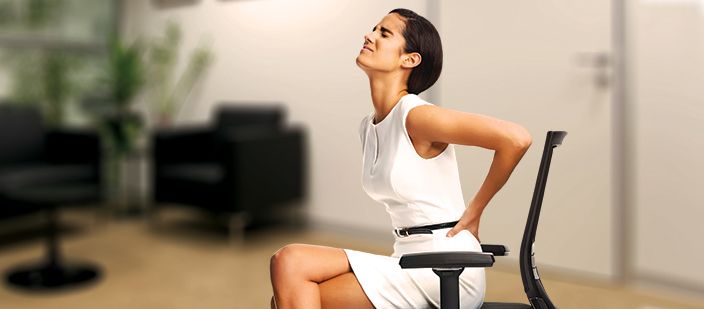Lower back pain is so common that approximately 8 out of 10 people complain about it at least once in their lifetime, regardless of their fitness level. You may have heard of a myriad of reasons for why it occurs ranging from tight muscles and spinal imbalances to depression and genetics. The truth, however, is that there is no single remedy for a problem that can have so many causes, and it needs to be assessed thoroughly before a diagnosis can be made. Of course, we aren’t here to make those diagnoses for you, but here is a little bit you should know about lower back pain so you know when to visit your healthcare provider!
To begin with, let’s take a look at common lower back pain problems.
Herniated Discs
These are also called bulging or ruptured discs. What happens here is that intervertebral discs that cushion the space between each vertebra become damaged or weakened. Though they are designed to handle constant pressure, sometimes excessive strain or injury cause them to move of place and result in cartilage bulging into the space that contains the spinal cord or nerve root. This is what causes pain, weakness, and even numbness. Most herniated discs occur in the lower lumbar region of the spine.
Sciatica
this is the condition defined by any pain that is caused by irritation or compression of the sciatic nerve. The sciatic nerve runs along the back of the pelvis, through the buttocks, and all the way down both legs, ending at the feet. When the nerve is irritated, pain often radiates from the lower back, travels through the buttocks, down one leg to below the knee, and occasionally reaches the foot as well. Ruptured or herniated discs are the most common cause of sciatica, though there are exceptions. Sometimes the condition is a result of injury, spinal stenosis (when the nerve passages in the spine narrow), infection or a growth in the spine.
Spinal Stenosis
this is related to the congenital narrowing of the bony canal, which often compresses the spinal nerves and most often results in leg pain, among other symptoms.
Spinal Degeneration
also loosely termed ‘degenerative disc disease’, this is due to wear and tear of the discs that make up the spine. This manifests as stiffness in the back after long bouts of standing or walking, or even after waking up after a long nap or a night’s sleep.
Osteoporosis
common to older individuals, especially postmenopausal women, osteoporosis is a metabolic bone disease that results when the body’s ability to generate new bone cannot keep up with the body’s natural rate of bone absorption and/or removal. This leads to a progressive decrease in the density and strength of the bones and makes them brittle, which is why even minor injuries, bending over, and even coughing may result in fractures.
Fibromyalgia
this chronic disorder commonly presents as pervasive musculoskeletal pain, constant fatigue, and tender areas specifically in the neck, spine, hips, and shoulders. It can also cause anxiety, sleep disturbances, and morning stiffness.
Spinal Irregularities
these usually relate to mild to moderate spinal curvature that creates a strain on the vertebrae and its supporting tissues (tendons, ligaments, muscles). These include scoliosis, a lateral curving of the spine; kyphosis, where the normal curve of the upper back is exaggerated; and, lordosis, when the arch in the lower back is abnormally accentuated.
Spondylitis
this chronic type of back pain is the result of inflammation in the spinal joints, causing discomfort and stiffness. Back pain and joint pain from spondylitis (and related diseases) is inflammatory in nature and not mechanical.
In terms of basic lower back locomotive problems, there are two general categories into which most people fall: flexion-intolerant individuals and extension-intolerant individuals.
For most people, approximately 90% of all back problems stem from flexion intolerance. This usually has to do with a herniated or bulging disc. Extension intolerance, on the other hand, may be caused by an exaggerated lumbar curve (which is usually the body’s way to compensate for a lack of mobility somewhere else) or vertebral fracturing.
Flexion intolerant individuals will exhibit traits like rounding their spine when lifting something off the floor, or tucking their hips (pelvis) if asked to squat deep. Their hamstrings are usually very tight as well. These signs point to the gluteal muscles not pulling their weight, and this forces their back muscles to compensate and avoid leaning forward as much as possible. So what is the key to alleviating this weakness? Work those gluts and that core! This will not only help your hamstrings feel better, but your gluts and spinal muscles will become stronger so that flexion is not as much of a problem. What is important for flexion intolerant people to understand is that their bodies will try their best to maintain their lumbar curve for protection. Avoid rounding your back during stretches or exercises, even though it may feel better at the time. Arching your back will also strengthen your posterior chain. Exercises to try are:
- Plank
- Hip thrust
- Romanian dead lifts
- Sumo dead lifts
- Front squats
Extension intolerance occurs when the lumbar curve is accentuated, and this in turn leads to weaker abdominal muscles and tight hip flexors. Dead lifts are usually very difficult for people who are extension intolerant. Again, strengthening the core and the gluts is the key to alleviating this problem. However, the reasoning is different; for extension intolerance, stronger gluts will assist in bringing the pelvis (hips) into a natural posterior tilt and reduce the lumbar curve while flexion intolerant people require the gluts to help with hip extension. More important for extension intolerance is ab-work, or technically, anterior core work. Direct lower back work is often the worst idea, especially if the load is too great and causes the lower back to compensate by arching. Essentially, in this case, we want to minimize the arch and avoid hyper extension. Rounding the spine for a few exercises will not be as detrimental for extension intolerant individuals. Exercises to try are:
- Dead bug
- Lying leg curl (low weight)
Once you’ve got a pretty good idea about which type of intolerance you may have, there is a test that you could do to confirm your prognosis. The McKenzie Test will relieve most flexion-intolerant people, but extension-intolerant people will find it painful and probably feel worse. Start by lying down on your stomach and propping yourself up on your elbows. Stay like this for about a minute and then bring your head down so that your forehead rests on the back of your hands. Remain this way for about 10-15 seconds and return to the propped up position. Repeat the sequence a couple of times and then stand up. If you feel better, the problem is flexion; if you feel worse, the problem is extension.
To reiterate, lower back issues are unique to each of us. There is no clear-cut solution, or one-size-fits-all remedy for back problems. However, it does help to know your own body well enough to understand what exercises work for you and how much you can handle. Proper form and technique is paramount to avoiding further injury and if your problems are chronic or severe, it is best to visit your health care provider.


